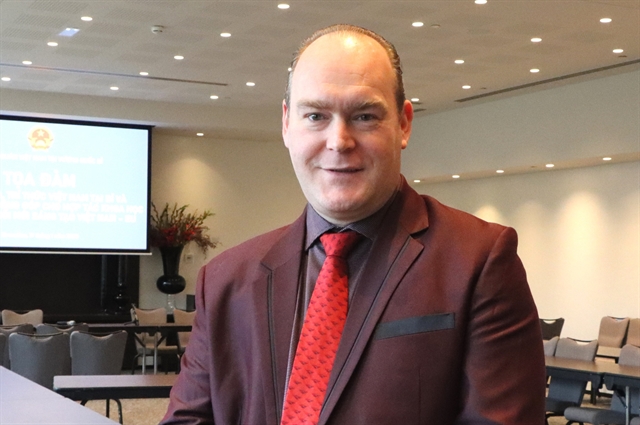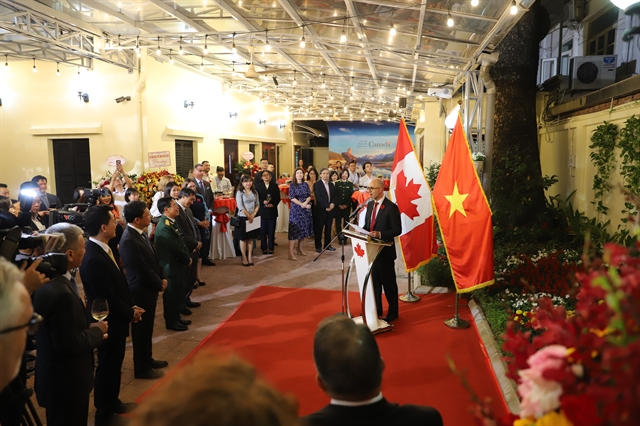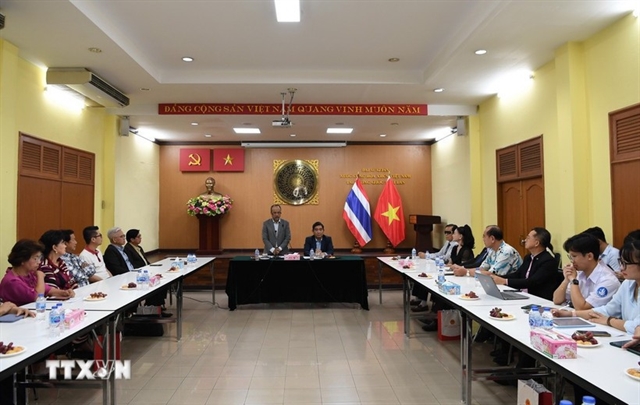 Opinion
Opinion

 |
| Canadian Ambassador to Việt Nam Shawn Perry Steil speaks at the 5th anniversary of the Comprehensive Partnership held at the Canadian Embassy on Tuesday. — Photos courtesy of the Embassy |
In a recent interview with media on the 5th anniversary of the Comprehensive Partnership between the two countries, Canadian Ambassador to Việt Nam Shawn Perry Steil talks about the potential to further improve trade and investment as well as plans to help Việt Nam tackle climate change.
Regarding the impacts of climate change, how can and will Canada help Việt Nam with the energy transition? Which capabilities and capacities can Canada bring to Việt Nam? As Mekong Delta is a region most vulnerable to climate change in Việt Nam, what are the plans of Canada to help the region adapt to and mitigate the impacts of climate change?
Let me address two parts of that question in terms of climate change mitigation and adaptation.
So on mitigation, it's about reducing greenhouse gas emissions. Canada has already begun to play a role in supporting Việt Nam’s efforts to reduce emissions. And we've done that in the first instance through our development assistance.
I was actually surprised to learn that rice and the growing of rice is a major greenhouse gas intensive industry, but by adapting rice growing practices and varieties, greenhouse gas emissions can be reduced significantly.
And in the Mekong Delta, as you mentioned, it's not only an issue of mitigation but also adaptation. With greater saltwater intrusion into the Delta, growing rice becomes more difficult.
When I first arrived in Việt Nam, I had the opportunity to visit Sóc Trăng, where Canada has been working for many years to help develop new varieties of rice and new rice farming techniques, including things like raising shrimp in rice paddies when the salt content is higher.
Energy transition is another key piece.
Canada has supported pilot projects to demonstrate offshore solar power potential in Việt Nam and Canada has a great deal of experience to offer in transitioning away from coal.
Transitioning away from coal is complicated. It involves not just alternative energy production, it also means retraining and supporting the development of economies that depend on coal.
As a member of the G7, Canada is optimistic that Việt Nam’s partnership with the just energy transition partnership will open new doors for more Canadian and G7 and international assistance and financing to help that transition in Việt Nam.
And finally, Canada has a comprehensive approach to supporting Việt Nam's efforts to respond to climate disasters and the economic impacts of climate change.
Over the past five years, we can see that the bilateral relations between Canada and Việt Nam have grown in a variety of areas. So how do you see the focus areas for the next five years in that relationship?
A comprehensive partnership means that we're committed to doing more in all areas. But in terms of where the greatest potential is over the next five years, clearly trade and investment relationship is just beginning to blossom. Canada has been committed and continues to be committed for the long-term development and reform of Việt Nam, and the next five years, I believe, will be a crucial period for Việt Nam’s development.
Việt Nam has this remarkable economic recovery happening right now, very high rates of growth and an enormous amount of international attention at the moment, so it represents a strategic opportunity for Việt Nam.
Through our development assistance and our diplomatic partnerships, Canada hopes to stand by Việt Nam's side as it moves through the next phase of strategic development.
Canada’s Indo-Pacific Strategy will be released within days, could you please share some information about it? What is the role of Việt Nam in Canada’s Indo-Pacific strategy?
I believe that the strategy will be released, at least a summary of the strategy will be released soon.
It's taken time for Canada to produce this because I believe our government wanted to have a very comprehensive approach. I think you can read the signs, such as the visit of my foreign minister to Việt Nam in April this year, that Canada sees Việt Nam playing a very significant role in ASEAN and in the Indo Pacific.
Việt Nam's economic growth and its reform process make it a pivotal player in this region. Canada believes that a strong, prosperous, open and inclusive Việt Nam is key to a stable and peaceful Indo Pacific.
According to statistics of the Ministry of Planning and Investment, Canadian investment in Việt Nam is only around US$2 billion, which is still low, considering the great potential between the two countries. So how do you assess the prospects of investment between two countries? And what are the areas of focus that Canadian investors are interested in here in Việt Nam?
We're below potential but I'm not worried about the growth rate yet. Statistics about our trading relationship show that Canada is the 10th largest market within the top 10 large markets for Việt Nam, but only around 14 highest investors.
Experience suggests that investment chases exports. So once the export market is growing, and the trade is growing, those partnerships start to identify themselves and people start to look for where they can invest.
Canadian investors, for the most part, are taking advantage of low-cost high-quality manufacturing in Việt Nam but increasingly, looking at not only export markets, but actually manufacturing for the Vietnamese market.
So once we see that shift happening, investors' outlook is changing, more opportunities in the Vietnamese market and more investment will come.
Further proof of that is the insurance sector. Canadian insurance companies are leading investors and leading service providers in Việt Nam’s insurance industry.
We have small basis, but we're at, as they say, the bottom of the curve where we should see in the next five to ten years, as long as the investment environment is stable, consistent and transparent.
 |
| Canadian lobster is made more affordable to Vietnamese consumers thanks to the Comprehensive and Progressive Agreement for Trans-Pacific Partnership (CPTPP). |
Could you elaborate on the Vietnamese investment environment?
I would say that there's work that needs to be done. But we've seen improvements since 2019, and Việt Nam’s accession to the Comprehensive and Progressive Agreement for Trans-Pacific Partnership (CPTPP).
The CPPTPP actually provides a roadmap for Việt Nam to enhance its investment environment.
But when Việt Nam succeeded to the agreement, it was on the understanding that it would take time for Việt Nam to meet some provisions and standards of the agreement. Canada is actually looking at ways that we can further support Việt Nam to meet those standards in the agreement.
What I would highlight, and which is in the agreement is that European, North American markets and investors are increasingly looking to environmental sustainability and labour standards when they make their investment decisions.
Part of the agreement of the CPTPP is standards on environment and labour and Việt Nam is still working towards meeting those standards.
But I think that's an enormous opportunity for Việt Nam. In an era where supply chains are becoming fragile and unreliable, Việt Nam can become a reliable partner to ensure that critical supply chains are maintained. — VNS




